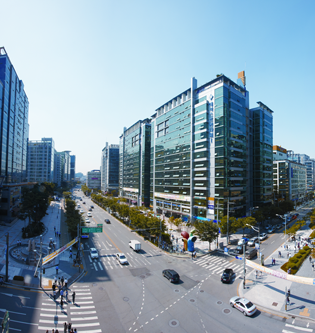District Features
- 홈
- About Guro-gu
- District Features
Geography
Located at the southwestern tip of Seoul, Guro-gu serves as a gateway to Seoul due to its proximity to Gimpo International Airport, Incheon Port, and the Seohaean Expressway. It also holds strategic significance as it is intersected by major transportation routes, including the Gyeongbu and Gyeongin railway lines, subway lines 1, 2, and 7, as well as the Gyeonin and Gyeongsu National Routes.
As Anyangcheon Stream truns through the district, dividing it into east and west living zones, it is crucial for the district to implement measures to foster closer connections between the two areas. Additionally, the district comprises significant green belt zones, covering 4.96 square kilometers (24.6% of the district area), and areas designated as pivotal for preventing urban sprawl, encompassing 2.1 square kilometers (10.4% of the district's total area) in Oryu 2-dong and Sugung-dong.
Furthermore, there are instances of incompatible land uses, such as the Yeongdeungpo Prison and Detention Center, within the urban neighborhood. These, along with undeveloped areas, emphasize the necessity for the district to undertake a comprehensive development project in order to establish links between the Sindorim and Guro Station areas, as well as the Cheonwang-dong and Hang-dong areas, including the former site of Yeongdeungpo Prison and Detention Center.
Society and Economy

Guro-gu is a prominent industrial district in Seoul, with approximately 34.6 percent (6.97㎢) of the entire district consisting of semi-industrial areas. Since the establishment of the Korea Export Industrial Complex (Guro Industrial Complex) in the 1960s, Guro-gu has been a pivotal hub for Korea's export industry. Notably, it is home to the world's largest mechanical tools complex, making a significant contribution to the economy of the metropolitan area.
In response to the rapidly evolving international economic landscape, the Guro Industrial Complex underwent a significant transformation in November 2000 and was renamed the Seoul Digital Industrial Complex. This transition was further propelled by the establishment of Korea's first venture valley, KICOX venture town, which accommodates 530 venture enterprises. As a result, Guro-gu is undergoing a remarkable metamorphosis, positioning itself as a hub for the cutting-edge digital industry, with a strong emphasis on knowledge-based sectors.
The Seoul Digital Industrial Complex currently boasts an occupancy rate of 79.2 percent, which is projected to surpass 80 percent by 2008. Guro-gu is now more readily accessible with the opening of subway line 7. With the scheduled relocation of the remaining large-scale plants, the district holds tremendous potential to evolve into a thriving hub for industry, economy, and distribution and achieve a perfect balance between residential and commercial sectors in the 21st century.
